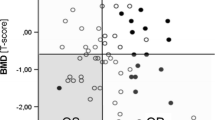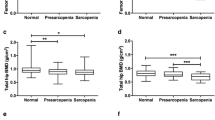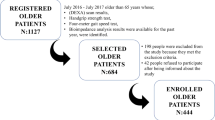Abstract
Summary
As muscle and bone are closely-related, we have explored the association between sarcopenia-related measurements and bone mineral density (BMD) (and osteoporosis) in postmenopausal women. Grip strength, anterior thigh muscle thickness and chair stand test were found to be related with BMD. Additionally, grip strength < 22 kg increased the odds ratio of osteoporosis 1.6 times.
Introduction
As muscle and bone are two closely related tissues, we aimed to investigate the association between sarcopenia-related measurements (i.e., sonographic anterior thigh muscle thickness, grip strength, chair stand test (CST), gait speed) and clinical factors, lumbar/femoral BMD, and the presence of osteoporosis (OP) in postmenopausal women.
Methods
Community dwelling postmenopausal women from two physical and rehabilitation medicine outpatient clinics were consecutively included in this cross-sectional study. Demographic data, age, weight, height, education/exercise status, smoking, and comorbidities were registered. BMD measurements were performed from lumbar vertebrae (L1-4) and femoral neck using dual energy X-ray absorptiometry (DXA). A T-score of ≤ -2.5 SD in the lumbar vertebrae (L1-L4) and/or femoral neck was accepted as OP. Anterior thigh muscle thickness (MT) at the midthigh level was measured sonographically using a linear probe. Grip strength was measured from the dominant side. Physical performance was assessed by CST and gait speed.
Results
Among 546 postmenopausal women, 222 (40.7%) had OP. Among sarcopenia-related parameters, grip strength and anterior thigh MT were positively associated with lumbar vertebral BMD. CST performance was positively associated with femoral neck BMD. After adjusting for confounding factors, low grip strength (< 22 kg) increased 1.6 times the risk of OP.
Conclusion
Loss of muscle mass/function (i.e., sarcopenia) can coexist with loss of trabecular and cortical bone. To this end, grip strength and anterior thigh MT seem to be associated with the lumbar vertebral BMD, while CST is associated with the femoral neck BMD. Lastly, low grip strength might have an association with postmenopausal OP.

Similar content being viewed by others
References
Greco EA, Pietschmann P, Migliaccio S (2019) Osteoporosis and sarcopenia increase frailty syndrome in the elderly. Front Endocrinol (Lausanne) 10:255. https://doi.org/10.3389/fendo.2019.00255
Kara M, Kaymak B, Frontera W, Ata AM, Ricci V, Ekiz T et al (2021) Diagnosing sarcopenia: functional perspectives and a new algorithm from the ISarcoPRM. J Rehabil Med 53:jrm00209. https://doi.org/10.2340/16501977-2851
Messier V, Rabasa-Lhoret R, Barbat-Artigas S, Elisha B, Karelis AD, Aubertin-Leheudre M (2011) Menopause and sarcopenia: a potential role for sex hormones. Maturitas 68:331–336. https://doi.org/10.1016/j.maturitas.2011.01.014
Hamad B, Basaran S, Coskun Benlidayi I (2020) Osteosarcopenia among postmenopausal women and handgrip strength as a practical method for predicting the risk. Aging Clin Exp Res 32:1923–1930. https://doi.org/10.1007/s40520-019-01399-w
Paintin J, Cooper C, Dennison E. Osteosarcopenia (2018) Br J Hosp Med 79:253–258. https://doi.org/10.12968/hmed.2018.79.5.253
Drey M, Sieber CC, Bertsch T, Bauer JM, Schmidmaier R, FiAT T, intervention group, (2016) Osteosarcopenia is more than sarcopenia and osteopenia alone. Aging Clin Exp Res 28:895–899. https://doi.org/10.1007/s40520-015-0494-1
da Cruz GF, Lunz TM, de Jesus TR, Costa MB, Vidigal CV, Albergaria BH et al (2021) Influence of the appendicular skeletal muscle mass index on the bone mineral density of postmenopausal women. BMC Musculoskelet Disord 22:861. https://doi.org/10.1186/s12891-021-04748-x
Geraci A, Calvani R, Ferri E, Marzetti E, Arosio B, Cesari M (2021) Sarcopenia and menopause: the role of estradiol. Front Endocrinol 12:1–5. https://doi.org/10.3389/fendo.2021.682012
Karvonen-Gutierrez C, Kim C (2016) Association of mid-life changes in body size, body composition and obesity status with the menopausal transition. Healthcare (Basel) 4:42. https://doi.org/10.3390/healthcare4030042
Clarke B (2008) Normal bone anatomy and physiology. Clin J Am Soc Nephrol 3:S131–S139. https://doi.org/10.2215/CJN.04151206
Assessment of fracture risk and its application to screening for postmenopausal osteoporosis. Report of a WHO Study Group. World Health Organ Tech Rep Ser. 1994;843:1–129
Schousboe JT, Shepherd JA, Bilezikian JP, Baim S (2013) Executive summary of the 2013 International Society for Clinical Densitometry Position Development Conference on bone densitometry. J Clin Densitom 16:455–466. https://doi.org/10.1016/j.jocd.2013.08.004
Akhter M, Lappe J, Davies K, Recker R (2007) Transmenopausal changes in the trabecular bone structure. Bone 41:111–116. https://doi.org/10.1016/j.bone.2007.03.019
Ravn P, Cizza G, Bjarnason N, Thompson D, Daley M, Wasnich R et al (1999) Low body mass index is an important risk factor for low bone mass and increased bone loss in early postmenopausal women. J Bone Miner Res 14:1622–1627. https://doi.org/10.1359/jbmr.1999.14.9.1622
Krall EA, Dawson-Hughes B (1999) Smoking increases bone loss and decreases intestinal calcium absorption. J Bone Miner Res 14:215–220. https://doi.org/10.1359/jbmr.1999.14.2.215
Cummings SR, Nevitt MC, Browner WS, Stone K, Fox KM, Ensrud KE et al (1995) Risk factors for hip fracture in white women. N Engl J Med 332:767–773. https://doi.org/10.1056/NEJM199503233321202
Lane NE, MD, (2006) Epidemiology, etiology and diagnosis of osteoporosis. Am J Obstet Gynecol 194:S3-11. https://doi.org/10.1016/j.ajog.2005.08.047
Ensrud KE, Lipschutz RC, Cauley JA, Seeley D, Nevitt MC, Scott J et al (1997) Body size and hip fracture risk in older women: a prospective study. Study of Osteoporotic Fractures Research Group. Am J Med 103:274–280. https://doi.org/10.1016/s0002-9343(97)00025-9
Todd JA, Robinson RJ (2003) Osteoporosis and exercise. Postgrad Med J 79:320–323. https://doi.org/10.1136/pmj.79.932.320
Anupama DS, Norohna JA, Acharya KK, Ravishankar GA (2020) Effect of exercise on bone mineral density and quality of life among postmenopausal women with osteoporosis without fracture: a systematic review. Int J Orthop Trauma Nurs 39:100796. https://doi.org/10.1016/j.ijotn.2020.100796
Brennan SL, Wluka AE, Gould H, Nicholson GC, Leslie WD, Ebeling PR et al (2012) Social determinants of bone densitometry uptake for osteoporosis risk in patients aged 50 yr and older: a systematic review. J Clin Densitom 15:165–175. https://doi.org/10.1016/j.jocd.2011.12.005
Du Y, Zhao LJ, Xu Q, Wu KH, Deng HW (2017) Socioeconomic status and bone mineral density in adults by race/ethnicity and gender: the Louisiana osteoporosis study. Osteoporos Int 28:1699–1709. https://doi.org/10.1007/s00198-017-3951-1
Bonds DE, Larson JC, Schwartz AV, Strotmeyer ES, Robbins J, Rodriguez BL et al (2006) Risk of fracture in women with type 2 diabetes: the Women’s Health Initiative Observational Study. J Clin Endocrinol Metab 91:3404–3410. https://doi.org/10.1210/jc.2006-0614
Ma L, Oei L, Jiang L, Estrada K, Chen H, Wang Z et al (2012) Association between bone mineral density and type 2 diabetes mellitus: a meta-analysis of observational studies. Eur J Epidemiol 27:319–332. https://doi.org/10.1007/s10654-012-9674-x
Leslie WD, Morin SN, Majumdar SR, Lix LM (2018) Effects of obesity and diabetes on rate of bone density loss. Osteoporos Int 29:61–67. https://doi.org/10.1007/s00198-017-4223-9
Schwartz AV, Vittinghoff E, Bauer DC, Hillier TA, Strotmeyer ES, Ensrud KE et al (2011) Association of BMD and FRAX score with risk of fracture in older adults with type 2 diabetes. JAMA 305:2184–2192. https://doi.org/10.1001/jama.2011.715
Lin YH, Chen HC, Hsu NW, Chou P, Teng MMH (2021) Hand grip strength in predicting the risk of osteoporosis in Asian adults. J Bone Miner Metab 39:289–294. https://doi.org/10.1007/s00774-020-01150-w
Kritz-Silverstein D, Barrett-Connor E (1994) Grip strength and bone mineral density in older women. J Bone Miner Res 9:45–51. https://doi.org/10.1002/jbmr.5650090107
Li YZ, Zhuang HF, Cai SQ, Lin CK, Wang PW, Yan LS et al (2018) Low grip strength is a strong risk factor of osteoporosis in postmenopausal women. Orthop Surg 10:17–22. https://doi.org/10.1111/os.12360
Dixon WG, Lunt M, Pye SR, Reeve J, Felsenberg D, Silman AJ et al (2005) Low grip strength is associated with bone mineral density and vertebral fracture in women. Rheumatol (Oxford) 44:642–646. https://doi.org/10.1093/rheumatology/keh569
Luo Y, Jiang K, He M (2020) Association between grip strength and bone mineral density in general US population of NHANES 2013–2014. Arch Osteoporos 15:47. https://doi.org/10.1007/s11657-020-00719-2
Khazzani H, Allali F, Bennani L, Ichchou L, El Mansouri L, Abourazzak FE et al (2009) The relationship between physical performance measures, bone mineral density, falls, and the risk of peripheral fracture: a cross-sectional analysis. BMC Public Health 9:297. https://doi.org/10.1186/1471-2458-9-297
Dai D, Xu F, Sun R, Yuan L, Sheng Z, Xie Z (2020) Decreased lower-extremity muscle performance is associated with decreased hip bone mineral density and increased estimated fracture risk in community-dwelling postmenopausal women. Arch Osteoporos 15:173. https://doi.org/10.1007/s11657-020-00835-z
Kara M, Kara Ö, Ceran Y, Kaymak B, Kaya TC, Çıtır BN et al (2022) SARcopenia assessment in hypertension: the SARAH study. Am J Phys Med Rehabil (In Press). https://doi.org/10.1097/PHM.0000000000002045
Author information
Authors and Affiliations
Corresponding author
Ethics declarations
Conflict of interest
None.
Additional information
Publisher's note
Springer Nature remains neutral with regard to jurisdictional claims in published maps and institutional affiliations.
Rights and permissions
Springer Nature or its licensor holds exclusive rights to this article under a publishing agreement with the author(s) or other rightsholder(s); author self-archiving of the accepted manuscript version of this article is solely governed by the terms of such publishing agreement and applicable law.
About this article
Cite this article
Tiftik, T., Kara, M., Koyuncu, E.G. et al. The relationship between sarcopenia-related measurements and osteoporosis: The SARCOP study. Osteoporos Int 34, 53–58 (2023). https://doi.org/10.1007/s00198-022-06563-z
Received:
Accepted:
Published:
Issue Date:
DOI: https://doi.org/10.1007/s00198-022-06563-z




